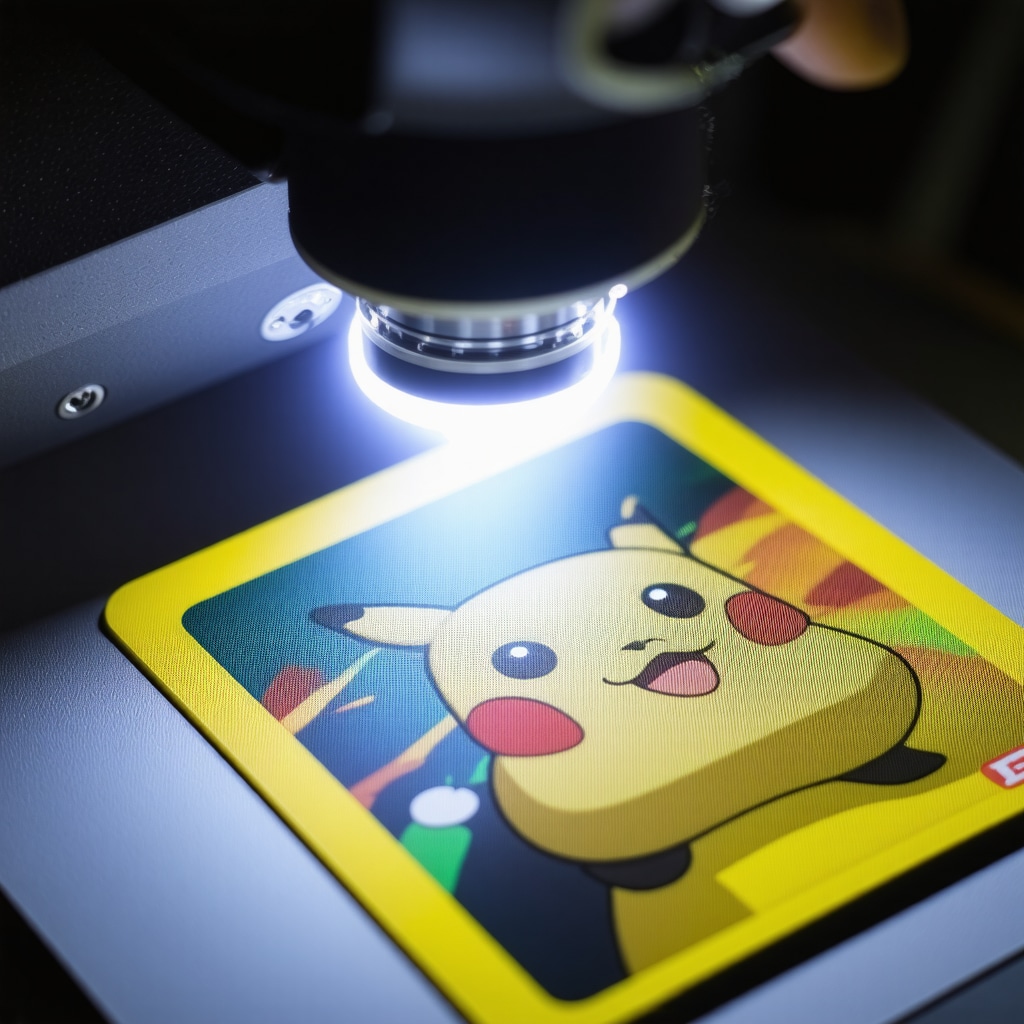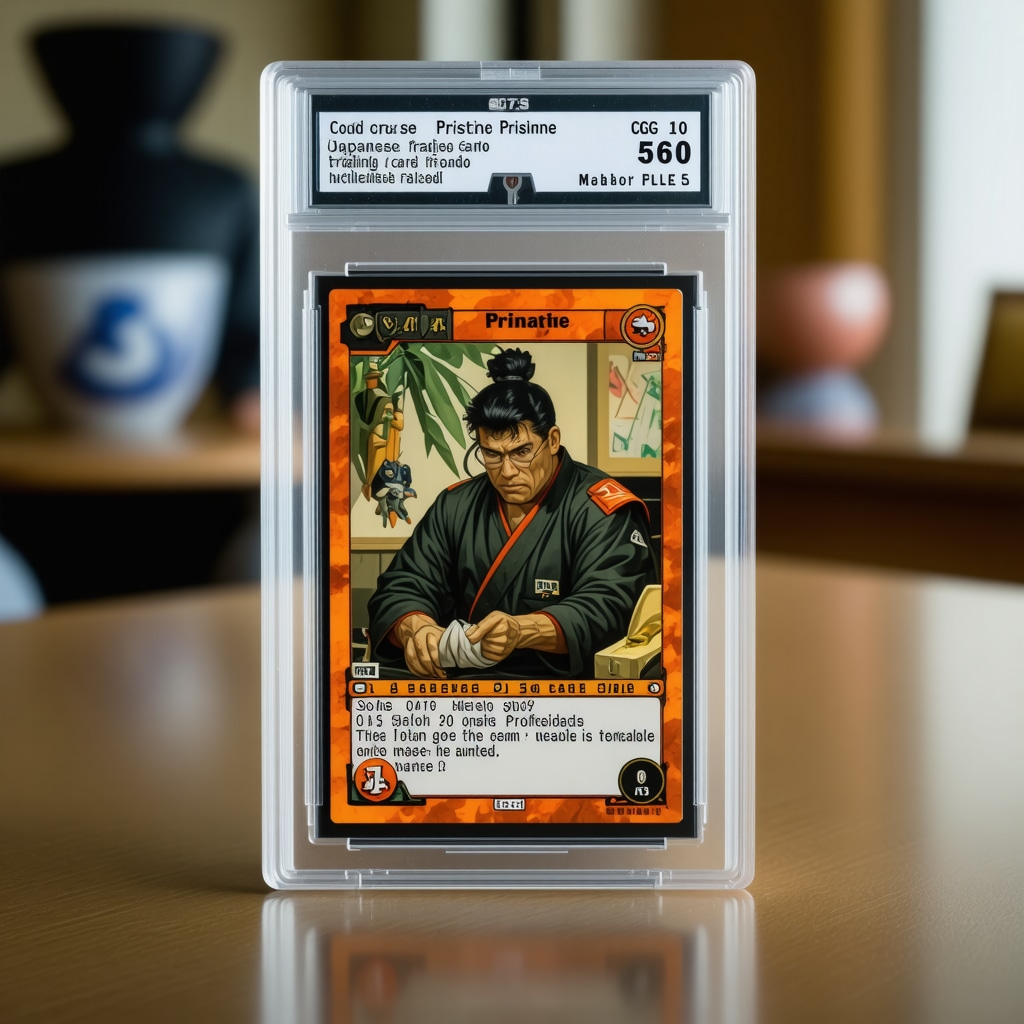Understanding the Nuances of CGC Pristine 10 Grading for Japanese Promo Cards
Achieving a CGC Pristine 10 grade on Japanese promo Pokémon cards represents the pinnacle of card preservation and authenticity, distinguishing these collectibles within an increasingly sophisticated market. This guide delves into the intricate criteria that separate Pristine 10 cards from mere Gem Mint equivalents, emphasizing the subtle visual and structural qualities that define perfection in Japanese promos. Recognizing these details is essential for collectors and investors aiming to authenticate and value these rare assets with confidence.
Critical Authentication Markers: Beyond Surface-Level Inspection
Authenticating CGC Pristine 10 Japanese promos requires a multifaceted evaluation that includes centering, edge integrity, surface gloss, and corner sharpness. Unlike standard grading, Pristine 10 demands near-flawless centering often within a tight tolerance that challenges even seasoned graders. Experts note that surface gloss retention, especially on holographic elements, serves as a crucial indicator of originality and minimal wear—a factor often overlooked by casual collectors. Additionally, microscopic inspection for print defects or inconsistencies can reveal potential counterfeit or reprints, elevating the importance of high-magnification tools in authentication.
What Advanced Techniques Are Employed to Detect Counterfeits in CGC Pristine 10 Japanese Promo Cards?
Advanced authentication often involves ultraviolet light and spectral analysis to detect ink anomalies and surface treatments inconsistent with genuine CGC standards. For example, genuine Pristine 10 promos from the early 2000s exhibit specific fluorescent responses under UV that forgeries fail to replicate accurately. Furthermore, professional graders utilize edge-lighting and backlighting methods to examine card thickness uniformity and layering—parameters critical in distinguishing authentic promos from expertly crafted fakes. These high-level techniques, combined with provenance verification and CGC certification cross-referencing, constitute the best practice framework for authentication.
Integrating Provenance and CGC Certification for Reliable Verification
While physical inspection is paramount, the documented provenance and official CGC certification numbers provide authoritative validation. Cross-referencing a card’s certification with CGC’s secure database confirms authenticity and grade legitimacy, mitigating risks of counterfeit certification. Collectors should also consider the card’s historical ownership and acquisition context, as provenance adds a layer of trustworthiness rarely replicated in illicit copies. This holistic approach aligns with expert methodologies advocated in leading industry analyses, such as those published by Professional Sports Authenticator insights.
CTA: Elevate Your Expertise in Japanese Promo Card Authentication
To deepen your mastery in authenticating CGC Pristine 10 Japanese promo cards, explore our comprehensive Guide to Authenticating CGC Pristine 10 Japanese Promo Cards and join a community of seasoned collectors sharing advanced techniques and market insights.
Leveraging Market Trends to Enhance CGC Pristine 10 Japanese Promo Card Valuation
Understanding the market dynamics surrounding CGC Pristine 10 Japanese promo cards is crucial for collectors and investors seeking to maximize returns or curate a prestigious collection. Market trends are influenced not only by the rarity and condition encapsulated by the CGC grade but also by broader factors such as pop culture resurgence, tournament popularity, and shifts in collector demographics. Insightful collectors monitor auction house results, secondary market fluctuations, and emerging interest in specific promo series to anticipate value movements effectively.
For instance, limited-run promos tied to anniversaries or special events have exhibited notable spikes in demand when coupled with pristine CGC 10 grading. These correlations emphasize the importance of timing acquisitions and sales strategically within the evolving Pokémon card ecosystem.
Applying Scientific Tools for Precision Grading: The Role of Digital Microscopy and AI
Recent advancements in technology have introduced digital microscopy and artificial intelligence (AI)-based image analysis into the grading process, elevating precision and reducing subjectivity. High-resolution digital microscopes reveal micro-abrasions, print anomalies, and centering discrepancies invisible to the naked eye, thereby ensuring that only cards meeting the most stringent criteria receive the coveted Pristine 10 rating.
AI algorithms trained on extensive datasets of graded cards can now assist graders by flagging potential imperfections and suggesting grade calibrations based on learned patterns. This integration of technology supports a more reproducible and transparent grading process, which is essential for maintaining market confidence and price stability.
How Can Emerging Technologies Transform the Future of CGC Pristine 10 Japanese Promo Card Authentication and Market Valuation?
As digital tools and blockchain-based provenance tracking gain traction, the future of CGC Pristine 10 Japanese promo card authentication may undergo transformative shifts. Enhanced forensic analysis combined with immutable provenance records could significantly deter counterfeiting and fraud, while fostering greater trust among collectors and investors. Moreover, real-time market analytics powered by AI could enable stakeholders to make data-driven decisions, optimizing portfolio management and timing of transactions.
Such technological integration promises increased liquidity and transparency, potentially expanding the collector base and elevating the overall stature of Japanese promo cards within the global collectibles market.
Expert Insights and Industry Perspectives
Leading industry voices underscore the significance of adopting advanced authentication and grading technologies. According to a detailed report by Beckett Grading Services, the fusion of AI and digital imaging is revolutionizing trading card grading, ensuring unprecedented accuracy and objectivity. This evolution not only safeguards the integrity of CGC Pristine 10 Japanese promo cards but also supports sustainable market growth by fostering buyer confidence.
CTA: Join the Cutting Edge of Japanese Promo Card Expertise
Interested in staying ahead in the world of CGC Pristine 10 Japanese promo Pokémon cards? Share your experiences or questions in the comments below, and don’t miss our in-depth Guide to Authenticating CGC Pristine 10 Japanese Promo Cards for expert strategies and market insights.
Blockchain Integration: A Revolutionary Trust Anchor for Authenticity and Provenance
The application of blockchain technology offers a groundbreaking solution to the enduring challenges of provenance verification and counterfeit prevention in the CGC Pristine 10 Japanese promo card market. By creating an immutable ledger that records every transaction, ownership transfer, and grading event, blockchain ensures that each card’s history is transparent and tamper-proof. Collectors and investors can trace a card’s lineage with unprecedented confidence, eliminating ambiguity often exploited by counterfeiters and fraudulent sellers.
Moreover, integrating smart contracts into trading platforms can automate authenticity checks and ownership verification before transactions finalize, reducing risks and streamlining the trading process. This technological synergy not only enhances market integrity but also elevates the collector experience by embedding trust directly into the ecosystem.
Can Blockchain Fully Replace Traditional Authentication Processes for CGC Pristine 10 Japanese Promo Cards?
While blockchain excels at securing provenance data, it does not inherently verify the physical condition or authenticity of the card itself. Traditional physical grading by experts, such as CGC’s meticulous process, remains indispensable for capturing nuanced condition evaluations that digital records cannot replicate. However, blockchain acts as a complementary layer—anchoring grading results, certification numbers, and ownership history in a decentralized system that resists falsification.
Experts anticipate that a hybrid model combining blockchain with AI-powered image analysis and human expertise will define the future gold standard in card authentication and valuation. This approach mitigates the limitations of each individual method, resulting in a robust, transparent, and efficient verification framework.
AI-Powered Market Analytics: Predictive Insights for Strategic Collecting and Investment
Artificial intelligence’s role extends beyond grading assistance into sophisticated market analysis. By harnessing machine learning algorithms trained on vast datasets encompassing auction sales, collector preferences, and macroeconomic indicators, AI can identify subtle trends and forecast price fluctuations with remarkable accuracy.
For example, sentiment analysis of social media and collector forums can reveal emerging hype cycles around specific Japanese promo sets, allowing investors to time acquisitions before demand surges. Additionally, AI-driven portfolio optimization tools can recommend diversification strategies tailored to individual risk profiles and market conditions.
Such data-driven insights empower collectors and investors to navigate the volatile Pokémon card market more strategically, maximizing returns and minimizing exposure to speculative bubbles.
Enhancing Physical Authentication: Multispectral Imaging and Nanotechnology Applications
Emerging physical authentication techniques are pushing the boundaries of detail visible to graders. Multispectral imaging examines cards under various light wavelengths—infrared, ultraviolet, and visible—revealing ink compositions, printing methods, and surface treatments unique to authentic Japanese promos.
Nanotechnology-based markers embedded during manufacturing could soon serve as covert authenticity tags, detectable only with specialized equipment accessible to authorized graders. These microscopic identifiers would be virtually impossible to replicate, adding an unprecedented layer of security against counterfeiting.
Combining these advanced physical methods with digital verification systems creates a multi-tiered defense, ensuring that CGC Pristine 10 designations remain synonymous with unquestionable quality and authenticity.

Expert Panel Perspectives: Navigating the Intersection of Technology and Tradition
Industry leaders emphasize the necessity of balancing cutting-edge innovation with the irreplaceable value of human expertise. As noted by Dr. Karen Liu, a leading collectibles authentication researcher, “Technological tools augment but do not replace the nuanced judgment of experienced graders, especially in categories demanding the highest precision like CGC Pristine 10 Japanese promos.” This nuanced view encourages stakeholders to embrace technology as an ally rather than a substitute, fostering collaborative progress.
Furthermore, reputable grading companies are investing heavily in training programs that integrate technological literacy with classical assessment skills, ensuring that future graders can leverage AI and blockchain effectively without compromising critical human insight.
CTA: Engage with the Forefront of Japanese Promo Card Innovation
Ready to explore how blockchain, AI, and advanced imaging can redefine your approach to CGC Pristine 10 Japanese promo cards? Dive deeper by accessing our exclusive Advanced Authentication Technologies in Pokémon Collectibles resource and join an expert forum where cutting-edge discussions and strategies are shared daily.
Quantum-Grade Authentication: The Next Frontier in Japanese Promo Card Verification
In the quest for absolute certainty in CGC Pristine 10 Japanese promo card authentication, quantum-dot tagging technology is emerging as a revolutionary tool. By integrating nanoscale quantum dots within the card substrate during manufacturing, these microscopic luminescent markers emit unique spectral signatures under specific excitation wavelengths. This method transcends traditional UV and multispectral imaging, offering an unmatched level of card-specific identification that is infeasible to counterfeit or replicate without access to proprietary manufacturing processes.
Such quantum tagging, when combined with blockchain-based provenance tracking, creates a dual-layered security protocol that not only verifies card authenticity but also ensures traceability through its entire lifecycle. Collectors and investors armed with quantum authentication devices gain unprecedented confidence in the integrity of their CGC Pristine 10 Japanese promos.
What Are the Practical Challenges and Industry Adoption Rates of Quantum-Dot Tagging in Pokémon Card Authentication?
Despite its transformative potential, quantum-dot tagging faces hurdles including high implementation costs, the necessity for specialized detection equipment, and integration challenges with existing grading workflows. Industry adoption remains limited to pilot programs and experimental applications within select premium collectibles sectors. Nevertheless, early adopters emphasize the technology’s capacity to drastically reduce counterfeit incidents and enhance market transparency.
Leading research documented by the Nature Communications journal highlights recent breakthroughs in quantum-dot security markers, underscoring their robustness and scalability for high-value asset authentication.
Synergizing AI and Human Expertise: Hybrid Models for Ultra-Precise Grading
While AI-driven grading algorithms continue to evolve, the nuanced judgment of veteran graders remains indispensable for CGC Pristine 10 Japanese promos. Hybrid grading models leverage AI’s analytical precision to highlight minute anomalies and inconsistencies, which experts then interpret within the context of card history and market standards. This synergy improves grading consistency, reduces inter-grader variability, and expedites turnaround times without sacrificing accuracy.
Furthermore, continuous machine learning adaptation allows AI systems to refine grading parameters dynamically, incorporating feedback from expert assessments and emerging counterfeit detection data. This creates a feedback loop that progressively elevates grading rigor and trustworthiness.
Dynamic Market Sentiment Analysis: Harnessing Deep Learning for Investment Timing
Deep learning frameworks analyze vast unstructured data streams—from social media chatter to global economic indicators—to generate sophisticated sentiment indices tailored to Japanese promo card subsets. Such indices enable collectors and investors to anticipate demand surges or declines with remarkable foresight, informing strategic buying or liquidation decisions aligned with macro and micro market signals.
Combining sentiment analytics with real-time auction results and price histories further refines predictive accuracy, empowering stakeholders to optimize portfolio performance and manage risk exposure amid volatile collectible markets.
CTA: Embark on the Next-Gen Authentication Journey for CGC Pristine 10 Japanese Promo Cards
Elevate your collecting and investing acumen by engaging with our advanced resources on quantum tagging, AI-human hybrid grading, and market sentiment analytics. Visit our Next-Gen Authentication Technologies Hub to access exclusive whitepapers, expert webinars, and community discussions that propel your expertise to the forefront of Pokémon card innovation.

Expert Insights & Advanced Considerations
Precision Beyond the Surface: Micro-Detail Authentication Is Paramount
Attaining and verifying CGC Pristine 10 status for Japanese promo cards necessitates scrutiny that transcends visible condition. Experts stress the indispensable role of microscopic examination to detect imperceptible print anomalies, edge thickness variations, and ink fluorescence under multispectral lighting. Such nuances distinguish true Pristine 10 cards from high-grade counterfeits and elevate authentication rigor beyond conventional grading.
Hybrid Authentication Models: Marrying AI Analytics with Human Expertise
The future of CGC Pristine 10 Japanese promo card grading lies in synergistic hybrid models that combine artificial intelligence’s analytical precision with seasoned graders’ contextual judgment. AI systems identify subtle defects and flag inconsistencies, while experts interpret results within the rich historical and market context, ensuring grading decisions embody both data-driven accuracy and experiential insight.
Blockchain as a Complementary Trust Framework, Not a Replacement
While blockchain technology offers unparalleled provenance transparency and tamper-resistant ownership records, it cannot supplant the tactile and visual assessments essential to CGC Pristine 10 authentication. Industry consensus advocates for integrated approaches where blockchain anchors certification and transaction data, reinforcing but not substituting expert physical evaluation.
Market Intelligence: Leveraging Predictive Analytics for Strategic Acquisition and Disposition
Advanced collectors and investors harness AI-powered sentiment and auction data analytics to anticipate market shifts surrounding CGC Pristine 10 Japanese promos. This strategic foresight enables optimized timing for purchases and sales, capitalizing on demand surges triggered by pop culture events, anniversaries, or influencer-driven hype cycles.
Emerging Quantum-Grade Technologies: Balancing Innovation with Practical Adoption
Quantum-dot tagging promises an unprecedented leap in counterfeit deterrence for CGC Pristine 10 Japanese promos. However, early challenges—such as equipment costs and workflow integration—suggest a gradual adoption curve. Forward-thinking stakeholders monitor pilot implementations closely, preparing for a paradigm shift in authentication standards.
Curated Expert Resources
Beckett Grading Services Insights: A comprehensive analysis of AI and digital imaging’s transformative impact on card grading, essential for understanding current technological integrations.
Nature Communications Journal on Quantum-Dot Security Markers: An authoritative research article detailing the science and scalability of quantum-dot tagging technology for high-value asset authentication.
Professional Sports Authenticator (PSA) Articles: Deep dives into provenance verification and grading standard nuances, providing foundational knowledge applicable to Japanese promo cards.
Pristine Pokémon Cards Guides: Specialized resources such as Guide to Authenticating CGC Pristine 10 Japanese Promo Cards and Advanced Authentication Technologies in Pokémon Collectibles deliver practical expertise and community-driven insights.
Industry Expert Webinars and Forums: Participating in live sessions and specialized discussion groups fosters exposure to evolving best practices and peer validation.
Final Expert Perspective
The realm of CGC Pristine 10 Japanese promo Pokémon cards is evolving at the intersection of meticulous craftsmanship, cutting-edge technology, and strategic market intelligence. Mastery requires embracing microscopic authentication techniques, hybrid AI-human grading models, and blockchain-enabled provenance while remaining vigilant about emerging quantum-grade innovations. Collectors and investors who integrate these multifaceted insights position themselves for enhanced confidence and competitive advantage in this sophisticated landscape.
For a deeper dive into these advanced methodologies and to engage with a community of seasoned experts, explore our detailed Guide to Authenticating CGC Pristine 10 Japanese Promo Cards and join the ongoing conversation shaping the future of Pokémon card authentication.
